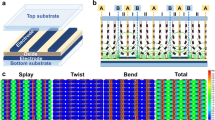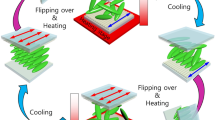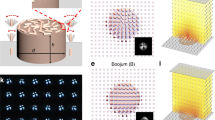Abstract
Current nematic liquid-crystal (LC) displays rely on voltage-induced reorientation of the director (the average molecular direction) within the bulk of the LC layer. In these devices, the surface region of the LC is strongly anchored to the cell walls and does not undergo reorientation at normal operating voltages. This situation is not optimal and indeed modelling has shown that weak anchoring of the LC can in principle lead to lower operating voltages and improved steepness in the electro-optic response1. Achieving weak anchoring in practice has proved difficult. Soft rubbing of a polymer2 or photoinduced ordering of a polymer3 coating the cell walls can lead to weak azimuthal (in-plane) anchoring, but a memory effect is still present which prevents high-speed surface reorientation. Some surface treatments, such as obliquely evaporated silicon oxide, can also induce weak anchoring, but only for a restricted range of temperatures4,5. Here we report a different approach to weak anchoring, which relies on the addition of small percentages of oligomeric molecules to the LC. This approach results in very small zenithal (out ofsubstrate plane) and azimuthal (in plane) anchoring energies. When applied to nematic displays, such treatments lead to a halving of the operating voltage.
This is a preview of subscription content, access via your institution
Access options
Subscribe to this journal
Receive 51 print issues and online access
$199.00 per year
only $3.90 per issue
Buy this article
- Purchase on Springer Link
- Instant access to full article PDF
Prices may be subject to local taxes which are calculated during checkout



Similar content being viewed by others
References
Nehring, J., Kmetz, A. R. & Scheffer, T. J. Analysis of weak boundary coupling effects in liquid crystal displays. J. Appl. Phys. 47, 850 –857 (1976).
Sato, Y., Sato, K. & Uchida, T. Relationship between rubbing strength and surface anchoring of nematic liquid crystals. Jpn J. Appl. Phys. A 31 , L579–L581 (1992).
Bryan-Brown, G. P. & Sage, I. C. Photoinduced ordering and alignment properties of polyvinylcinnamates. Liq. Cryst. 20, 825–829 (1996).
Yokohama, H. & Van Sprang, H. A. Anovel method for determining the anchoring energy function at a nematic liquid crystal interface from director distortions at high fields. J. Appl. Phys. 57, 4520–4526 (1985).
Faetti, A., Gatti, M., Palleschi, V. & Sluckin, T. J. Almost critical behaviour of the anchoring energy at the interface between a nematic liquid crystal and a SiO surface. Phys. Rev.Lett. 55, 1681–1684 (1985).
Vetter, P., Ohmura, Y. & Uchida, T. Study of memory alignment on nematic liquid crystals on polyvinyl alcohol coatings. Jpn J. Appl. Phys. 32 , L1239–L1241 (1993).
Rapini, A. & Popoular, M. Distortion d'une lamelle nematique sous champ magnetique conditions d'ancrage aux parois. J. Phys. (Paris) C 30, 54–56 ( 1969).
Sonin, A. A. The Surface Physics of Liquid Crystals 42–44 (Gordon & Breach, London, (1995).
Barbero, G., Dozov, I., Palierne, J. F. & Durand, G. Order electricity and surface orientation in nematic liquid crystals. Phys. Rev. Lett. 56, 2056–2059 (1985).
Flory, P. J. Principles of Polymer Chemistry 495–540 (Cornell Univ. Press, London, (1953).
Ichihara, S., Wakemoto, H., Nakazima, K. & Matsuo, Y. The effect of rubbed polymer films on liquid crystal alignment. Liq. Cryst. 4, 669–675 ( 1989).
Berreman, D. W. The alignment of liquid crystals by grooved surfaces. Mol. Cryst. Liq. Cryst. 23, 215–231 (1973).
Acknowledgements
We thank J. C. Jones, V. C. Hui and D. Coates for discussions.
Author information
Authors and Affiliations
Corresponding author
Rights and permissions
About this article
Cite this article
Bryan-Brown, G., Wood, E. & Sage, I. Weak surface anchoring of liquid crystals. Nature 399, 338–340 (1999). https://doi.org/10.1038/20646
Received:
Accepted:
Issue Date:
DOI: https://doi.org/10.1038/20646
This article is cited by
-
Anchoring energy of nematic liquid crystals on zinc oxide film
Journal of the Korean Physical Society (2021)
-
Decreasing the operating voltage of a polymer-stabilized blue phase based on intermolecular affinity
Polymer Journal (2019)
-
Stimuli-responsive hydroxyapatite liquid crystal with macroscopically controllable ordering and magneto-optical functions
Nature Communications (2018)
-
Topology-dependent self-structure mediation and efficient energy conversion in heat-flux-driven rotors of cholesteric droplets
Nature Communications (2018)
-
Measurement of the Casimir torque
Nature (2018)
Comments
By submitting a comment you agree to abide by our Terms and Community Guidelines. If you find something abusive or that does not comply with our terms or guidelines please flag it as inappropriate.



